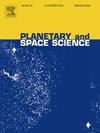Numerical experiments on the hydrodynamic structure of a barchan dune constrained by dense atmospheres: Comparative applications to Venus and Titan
IF 1.7
4区 物理与天体物理
Q3 ASTRONOMY & ASTROPHYSICS
引用次数: 0
Abstract
Venus and Titan, two very different terrestrial bodies in the solar system possessing extremely hot and extremely cold near-surface dense atmospheres, respectively, have been identified as having surface dune distributions associated with aeolian sand transport. Previous studies on planetary dunes have rarely involved a detailed investigation of flow behavior over dunes under such extreme environmental conditions. This study takes the highly migratory elementary barchan dune as the research object, and aiming at the realistic thermophysical environment of the wind field near the surfaces of Venus and Titan, a computational fluid dynamics model of the turbulent boundary layer on the surface that considers the real gas effect and planetary gravity constraints was constructed to carry out numerical experiments and comparative analysis of the hydrodynamic behavior of sand dunes induced by different planetary atmospheric environments. The predicted results show that there are notable differences in the leeward secondary flow structures of the barchan dunes induced by the real gas flows of Venus and Titan. Under the conditions of a 0-km elevation and the same incident flow speed, the flow reattachment length of the Venusian dune is slightly smaller than that of Titan's dune. This may be caused by differences in the thermo-hydrodynamics of planetary atmospheric fluids and differences in the turbulent flow represented by the flow Reynolds number. In essence, for Venusian dunes with high Reynolds number turbulence, the kinematic viscosity, as the only variable parameter, has no significant impact on the flow reattachment length. At the same wind intensity conforming to the in-situ data, for both Venus and Titan, the dune areas where the wind can cause fine sand of the same size to take off and subsequently be eroded tend to be located on the crest of the dune. The maximum dimensionless friction velocity, which is used to characterize the erosion intensity, decreases linearly with increasing elevation on Venus. This indirectly clarifies the previous argument about the relationship between planetary atmospheric density and aeolian geomorphology scales in a new light. The quantitative comparisons of the eroded extent and intensity on dune surfaces suggest that the induced effect of the atmospheric environment on Titan at 0 km is the closest to that on Venus at 11 km. This research can provide inspiration and a theoretical reference for the study of comparative planetology in the field of aeolian geomorphology.
受稠密大气约束的新月形沙丘水动力结构的数值实验:在金星和土卫六上的比较应用
金星和土卫六是太阳系中两个非常不同的类地天体,分别拥有极热和极冷的近地表致密大气,它们的表面沙丘分布与风沙运输有关。以往对行星沙丘的研究很少涉及在这种极端环境条件下沙丘流动行为的详细调查。本研究以高度迁移的初级坝状沙丘为研究对象,针对金星和土卫六表面风场的真实热物理环境,建立了考虑实际气体效应和行星重力约束的地表湍流边界层计算流体动力学模型,对不同行星大气环境下沙丘的水动力行为进行了数值实验和对比分析。预测结果表明,金星和土卫六实际气体流诱导的barchan沙丘背风二次流结构存在显著差异。在海拔0 km、入射流速相同的条件下,金星沙丘的水流再附着长度略小于土卫六沙丘。这可能是由于行星大气流体热流体力学的差异和以流动雷诺数表示的湍流的差异造成的。实质上,对于具有高雷诺数湍流的金星沙丘,运动粘度作为唯一的可变参数,对流动再附着长度没有显著影响。在符合现场数据的相同风强条件下,对于金星和土卫六来说,风能使相同大小的细沙起飞并被侵蚀的沙丘区域往往位于沙丘的顶部。用于表征侵蚀强度的最大无因次摩擦速度随着金星海拔的增加而线性降低。这从一个新的角度间接澄清了以往关于行星大气密度与风成地貌尺度关系的争论。对沙丘表面侵蚀程度和强度的定量比较表明,大气环境对土卫六在0公里处的诱导效应与金星在11公里处的诱导效应最接近。本研究可为风成地貌学领域的比较行星学研究提供启示和理论参考。
本文章由计算机程序翻译,如有差异,请以英文原文为准。
求助全文
约1分钟内获得全文
求助全文
来源期刊

Planetary and Space Science
地学天文-天文与天体物理
CiteScore
5.40
自引率
4.20%
发文量
126
审稿时长
15 weeks
期刊介绍:
Planetary and Space Science publishes original articles as well as short communications (letters). Ground-based and space-borne instrumentation and laboratory simulation of solar system processes are included. The following fields of planetary and solar system research are covered:
• Celestial mechanics, including dynamical evolution of the solar system, gravitational captures and resonances, relativistic effects, tracking and dynamics
• Cosmochemistry and origin, including all aspects of the formation and initial physical and chemical evolution of the solar system
• Terrestrial planets and satellites, including the physics of the interiors, geology and morphology of the surfaces, tectonics, mineralogy and dating
• Outer planets and satellites, including formation and evolution, remote sensing at all wavelengths and in situ measurements
• Planetary atmospheres, including formation and evolution, circulation and meteorology, boundary layers, remote sensing and laboratory simulation
• Planetary magnetospheres and ionospheres, including origin of magnetic fields, magnetospheric plasma and radiation belts, and their interaction with the sun, the solar wind and satellites
• Small bodies, dust and rings, including asteroids, comets and zodiacal light and their interaction with the solar radiation and the solar wind
• Exobiology, including origin of life, detection of planetary ecosystems and pre-biological phenomena in the solar system and laboratory simulations
• Extrasolar systems, including the detection and/or the detectability of exoplanets and planetary systems, their formation and evolution, the physical and chemical properties of the exoplanets
• History of planetary and space research
 求助内容:
求助内容: 应助结果提醒方式:
应助结果提醒方式:


